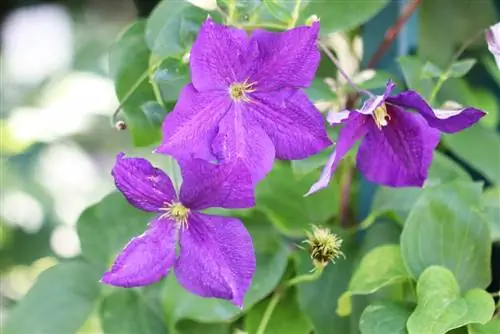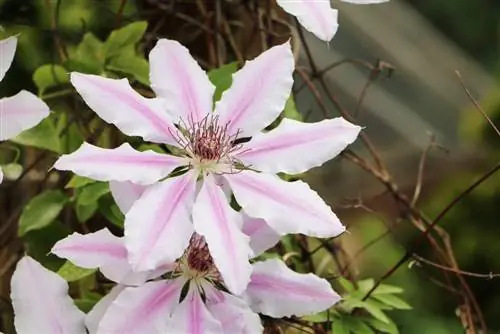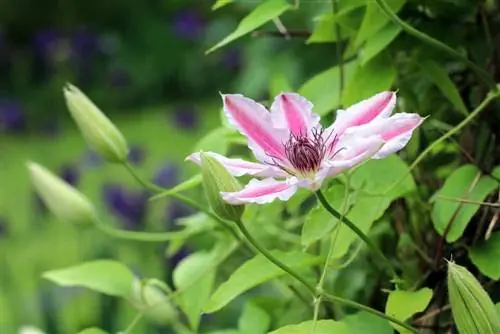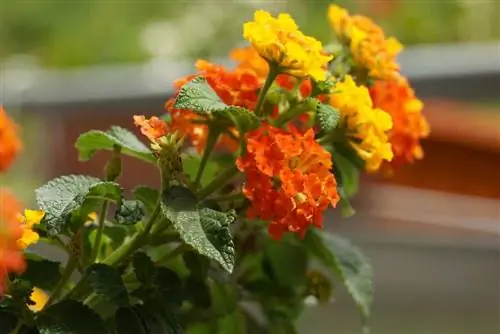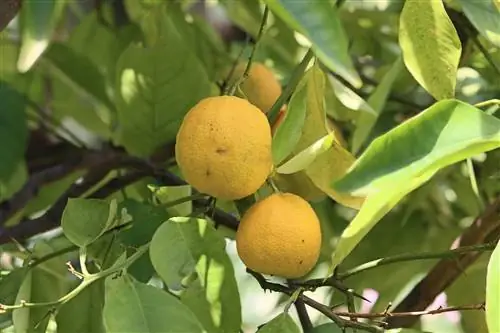- Author admin [email protected].
- Public 2023-12-17 03:39.
- Last modified 2025-01-24 12:45.
The Clematis 'The President' is a wonderful example that even a simple flower can inspire with its clear color alone. The blue-violet gains additional luminosity because the flowers are numerous and, above all, huge. Their diameter can be up to 18 cm. It may come as a surprise, but this lavish showpiece is extremely modest when it comes to its own needs.
Growth
The perennial climbing plant Clematis 'The President' effortlessly swings up into the sky on pergolas, trellises and trellises. With about half a meter of growth per year, it will soon tower over all other plants. Their flowers can even shine down on us from a height of 5 m. High up, nothing obscures their view; even from far away, 'The President' cannot be missed. While it still slumbers leaflessly and inconspicuously in winter, in summer it unfolds its magnificent green foliage, which soon has to recede into the second row to give the stage to the flowers.
Bloom
The simple purple flowers are the largest that the large clematis family has to offer. The flowers of this hybrid variety reach a diameter of approximately 18 cm. The size alone is impressive enough, and so the petals are kept rather simple. When the purple shines from May onwards, the green of the leaves only shimmers here and there and forms a beautiful contrast to the color of the flowers. Then this clematis is a popular meeting place for numerous insects, who don't miss its nectar and stop by for a snack. A humming concert sounds and testifies to the abundance of nature. A relief for our noise-plagued ears. Their flowering continues into September.
Location
Sunny or at least partially shaded should be the ideal location for this flowering climber. However, the roots of the clematis need shade and must be protected by ground cover or mulch. A location where there is already a natural climbing opportunity is optimal. A tree trunk and a wall work well for this. This clematis can even be used to grow an existing rose trellis. The 'The President' variety also thrives in pots and forms a colorful privacy screen in a short time. No matter where you plant clematis, make sure it is in a place protected from the wind. Their tendrils cannot withstand strong winds and it would be a shame if some of them were to tear off.
Floor
The deep-rooted clematis cannot thrive in hard soil. The soil must be loose and permeable. If the earth does not naturally have this composition, it must be subsequently mixed with other components. Soil that is too sandy still needs water-storing garden soil; soil that is too clayey and compacted needs to be loosened up with sand. This is best done before the clematis is planted. Since the clematis needs a lot of nutrients and trace elements to form the flowers, a high proportion of humus is an advantage. Horn shavings can also be added to the planting hole.
Planting out
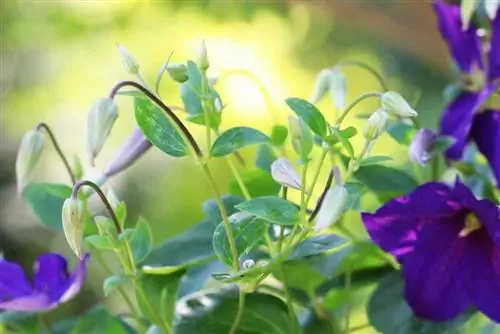
If you can offer the clematis a garden, you are making her happy. She is content with a large pot, but that is nothing compared to the development opportunities she has in open soil. The President' is frost hardy and so this hybrid variety can easily overwinter outside.
- Planting time: March to October
- sunny to partially shaded location
- The planting hole should be about twice as big as the root ball
- Add horn shavings into the planting hole as long-term fertilizer
- Carefully remove from the pot to avoid damaging the tendrils
- approx. Plant 10 cm deeper
- Planting distance between two clematis approx. 60 cm
- Distance to walls approx. 15 cm
- pour well
- water depending on the weather in the first few weeks
- Use ground cover to shade the root ball
- alternatively: spread a thick layer of mulch
Bucket keeping
Since climbing plants grow quickly, they are also often planted in planters to create terraces or balconies. At the same time, they also serve as green privacy screens. Since the clematis 'The President' also blooms beautifully, it is at the top of the popularity list. It can also be cultivated in a pot, but not in the pot in which it is sold commercially. Although it may be sufficient for pre-cultivation and practical for sales, it cannot meet your needs in the long term. It will need to be transplanted into a much larger container fairly soon so that it can continue to develop.
- Get a bucket with a volume of at least 25 liters. It should have plenty of holes in the bottom.
- Provide suitable soil. It should be loose and rich.
- First add a drainage layer of approx. 8 cm to the bucket.
- Fill some soil over it. The free space up to the edge of the container should be as high as the clematis ball plus 10 cm.
- Carefully remove the clematis from its old pot. To do this, hold the pot overhead and let the plant slide out into your other hand.
- Place the root ball straight in the new pot.
- Fill the spaces with soil. Press it lightly.
- If necessary, plant small plants to keep the root ball in the shade.
- Now water the plant well.
- Place the pot in a sunny or semi-shady place.
- Attach a climbing aid so that the clematis can hold on to it.
Tip:
The ball of the clematis should remain as intact as possible when removed so that the roots are not damaged. What is not a big problem with other plants is harmful to clematis. The soil in the pot should be replaced approximately every four to five years.
Fertilize
This richly flowering clematis needs a constant supply of nutrients almost all the time - with the exception of winter. Only then will she delight you with beautiful flowers. Horn shavings and other organic fertilizers are best, which are distributed around the roots in the spring from March to April and lightly incorporated. Further fertilization should be done with compost. It is released in December. This clematis should not be fertilized during the flowering period, as this can shorten the flowering time.
Pouring
If there is no rain for a long time in summer, the clematis needs to be watered. Especially during their growth and flowering phase from April to September, their roots must be in sufficiently moist soil. Because they absorb the nutrients necessary for the flowers along with water. If a clematis plant is left dry for a long time, flower production suffers. The more the sun shines on your location, the more often you have to pick up the watering can. Allow the top layer of soil to dry just slightly. During the rest of the year, the clematis, with its long and deep roots, is quite capable of taking care of itself. It copes well with the residual moisture present in the soil. There are a few rules to follow when watering your clematis:
- Waterlogging damages the roots
- young plants need to be watered more often
- Soil in pots dries out faster
- Provide pot clematis with water regularly
- Buckets should have large drainage holes
- Drainage layer allows water to drain away easily
- It's better to water less and more often
Cutting
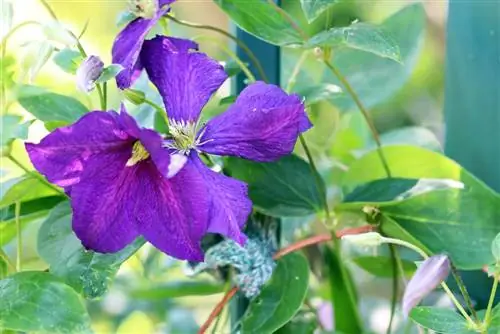
The right cut ensures that the clematis is decorated with flowers every year. When to cut the clematis and how much to cut depends on its flowering behavior. Based on this, the clematis varieties were divided into three different cutting groups. The variety 'The President' blooms from May/June and, like most large-flowered clematis, belongs to the second group. The following applies to plants in this group:
- Pruning time in late autumn after flowering
- cut away weak and dead shoots first
- shorten other shoots by 20 cm each
- Use sharp and clean secateurs
- Gardening gloves protect against contact allergies (mildly toxic)
- After the first flowering, remove the inflorescences and the pair of leaves underneath
No matter which cutting group a clematis belongs to, in the first winter after planting it should be shortened to around 30 cm above the ground. This encourages branching. Every four to five years, 'The President' should also be cut back heavily in the spring. This prevents baldness in the lower area. However, the flowering in the following summer is sparse.
Tip:
The early bloomer 'The President' blooms on previous year's shoots. It is therefore important that some of these shoots are left standing when cutting. Also use pruning shears for dead vines. Pulling on it could damage roots.
Diseases and pests
The dreaded wilt doesn't stop at this clematis either. If the above-ground parts of the plant are infected, they must be cut off close to the ground. Leaves that are lying on the ground must be collected. Unfortunately, if the roots of the plant are infected by the fungus, the clematis can no longer be helped.
Powdery mildew can occur occasionally and should be combated early to prevent the infestation from spreading even further.
Voles are a real pest in the garden. They seem to like the roots of the clematis. Unfortunately, they leave nothing behind, so the rootless plant ultimately dies. If a grid protection is placed around the root ball when planting, the voles can no longer get to the delicious roots.
Wintering
The Clematis 'The President' is hardy. It can overwinter outdoors unless grown in a pot. In this case, the clematis should overwinter in a bright and cool room. If there is no suitable winter quarters, it can stay outside. In order not to just hope for a mild winter, the pot with the roots should be well prepared for the winter. A sheltered location keeps icy winds away. In addition, the pot should be insulated by wrapping it with plenty of fleece.
A winter cover cannot harm outdoor clematis, especially if the vine is still young. A layer of fir branches protects their roots from very cold temperatures.

